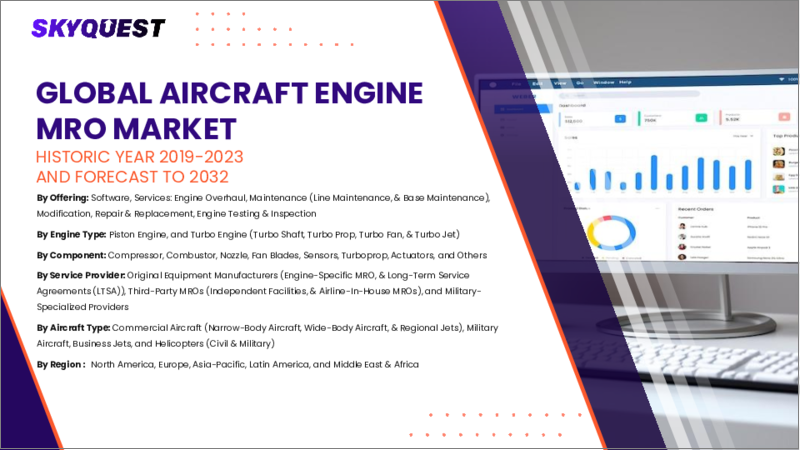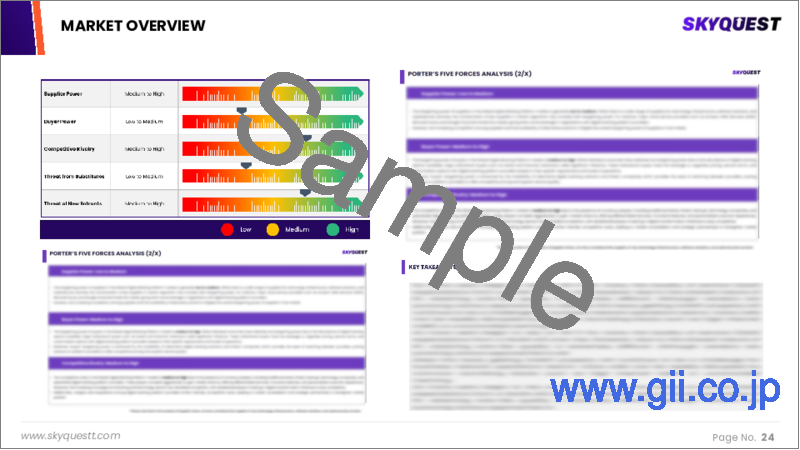|
|
市場調査レポート
商品コード
1734493
航空機エンジンMRO市場規模、シェア、成長分析、プラットフォーム別、コンポーネント別、エンジンタイプ別、地域別 - 産業予測 2025年~2032年Aircraft Engine MRO Market Size, Share, and Growth Analysis, By Platform (Commercial and Civil Aircraft, Military Aircraft), By Component (Compressor, Combustor), By Engine Type, By Region - Industry Forecast 2025-2032 |
||||||
|
|||||||
| 航空機エンジンMRO市場規模、シェア、成長分析、プラットフォーム別、コンポーネント別、エンジンタイプ別、地域別 - 産業予測 2025年~2032年 |
|
出版日: 2025年05月18日
発行: SkyQuest
ページ情報: 英文 191 Pages
納期: 3~5営業日
|
全表示
- 概要
- 目次
航空機エンジンMROの世界市場規模は2023年に428億1,000万米ドルとなり、予測期間(2025-2032年)のCAGRは4.6%で、2024年の447億8,000万米ドルから2032年には641億7,000万米ドルに成長する見通しです。
航空機エンジンMRO業界は、デジタル化と技術の進歩によって大きく変貌しつつあります。主要企業は、超音波センサーや振動センサーを活用してエンジン性能を監視し、故障を予測するIoTベースの予知保全ソリューションを統合しています。このような重要部品のリアルタイムのデータ追跡により、予防保全の強化が可能になります。さらに、人工知能は、従来のアプローチを最適化するための予測分析を活用した高度なデータモデリングとシミュレーションによって、メンテナンスに革命をもたらしています。この分野では、サービスネットワークの拡大と修理施設の混雑緩和を目的とした投資により、MROインフラとキャパシティも世界的に大きく成長しています。全体として、AI主導型技術の採用は、航空会社の信頼性を高め、コストを削減し、ターンアラウンドタイムを加速させ、整備戦略の極めて重要な転換を意味します。
目次
イントロダクション
- 調査の目的
- 調査範囲
- 定義
調査手法
- 情報調達
- 二次と一次データの方法
- 市場規模予測
- 市場の前提条件と制限
エグゼクティブサマリー
- 世界市場の見通し
- 供給と需要の動向分析
- セグメント別機会分析
市場力学と見通し
- 市場概要
- 市場規模
- 市場力学
- 促進要因と機会
- 抑制要因と課題
- ポーターの分析
主な市場の考察
- 重要成功要因
- 競合の程度
- 主な投資機会
- 市場エコシステム
- 市場の魅力指数(2024年)
- PESTEL分析
- マクロ経済指標
- バリューチェーン分析
- 価格分析
航空機エンジンMRO市場規模:プラットフォーム別& CAGR(2025-2032)
- 市場概要
- 商用航空機および民間航空機
- ナローボディ
- ワイドボディ
- リージョナル航空機
- ビジネスジェット
- 練習機とターボプロップ機
- 商用ヘリコプター
- 軍用機
- マルチロールと戦闘
- 軍用輸送機
- 軍事トレーナー
- 軍用ヘリコプター
航空機エンジンMRO市場規模:コンポーネント別& CAGR(2025-2032)
- 市場概要
- コンプレッサー
- 燃焼器
- ノズル
- ファンブレード
- センサー
- アクチュエータ
- その他
航空機エンジンMRO市場規模:エンジンタイプ別& CAGR(2025-2032)
- 市場概要
- ピストンエンジン
- ターボエンジン
- ターボシャフト
- ターボプロップ
- ターボファン
- ターボジェット
航空機エンジンMRO市場規模:地域別& CAGR(2025-2032)
- 北米
- 米国
- カナダ
- 欧州
- ドイツ
- スペイン
- フランス
- 英国
- イタリア
- その他欧州地域
- アジア太平洋地域
- 中国
- インド
- 日本
- 韓国
- その他アジア太平洋地域
- ラテンアメリカ
- ブラジル
- その他ラテンアメリカ地域
- 中東・アフリカ
- GCC諸国
- 南アフリカ
- その他中東・アフリカ
競合情報
- 上位5社の比較
- 主要企業の市場ポジショニング(2024年)
- 主な市場企業が採用した戦略
- 最近の市場動向
- 企業の市場シェア分析(2024年)
- 主要企業の企業プロファイル
- 企業の詳細
- 製品ポートフォリオ分析
- 企業のセグメント別シェア分析
- 収益の前年比比較(2022-2024年)
主要企業プロファイル
- GE Aerospace(United States)
- Safran Aircraft Engines(France)
- MTU Aero Engines AG(Germany)
- Rolls-Royce Holdings plc(United Kingdom)
- Honeywell Aerospace(United States)
- Williams International(United States)
- Magellan Aerospace Corporation(Canada)
- SIA Engineering Company(Singapore)
- Delta TechOps(United States)
- AAR CORP.(United States)
- Sabena Technics(France)
- Turkish Technic(Turkey)
- Air France Industries KLM Engineering & Maintenance(AFI KLM E&M)(France)
- ST Engineering Aerospace(Singapore)
- HAECO(Hong Kong Aircraft Engineering Company)(Hong Kong)
- Lufthansa Technik AG(Germany)
- ITP Aero(Spain)
- FL Technics(Lithuania)
- Singapore Aero Engine Services Private Limited(SAESL)(Singapore)
- Pem-Air Turbine Engine Services, LLC(United States)
結論と提言
Global Aircraft Engine MRO Market size was valued at USD 42.81 billion in 2023 and is poised to grow from USD 44.78 billion in 2024 to USD 64.17 billion by 2032, growing at a CAGR of 4.6% during the forecast period (2025-2032).
The aircraft engine MRO industry is transforming profoundly through digitalization and technological advancements. Key players are integrating IoT-based predictive maintenance solutions that utilize ultrasonic and vibration sensors to monitor engine performance and forecast failures. This real-time data tracking of critical components allows for enhanced preventive maintenance practices. Additionally, artificial intelligence is revolutionizing maintenance with advanced data modeling and simulation, utilizing predictive analytics to optimize traditional approaches. The sector is also witnessing significant growth in MRO infrastructure and capacity globally, with investments aimed at expanding service networks and reducing congestion in repair facilities. Overall, the adoption of AI-driven technologies enhances reliability, reduces costs, and accelerates turnaround times for airlines, representing a pivotal shift in maintenance strategies.
Top-down and bottom-up approaches were used to estimate and validate the size of the Global Aircraft Engine MRO market and to estimate the size of various other dependent submarkets. The research methodology used to estimate the market size includes the following details: The key players in the market were identified through secondary research, and their market shares in the respective regions were determined through primary and secondary research. This entire procedure includes the study of the annual and financial reports of the top market players and extensive interviews for key insights from industry leaders such as CEOs, VPs, directors, and marketing executives. All percentage shares split, and breakdowns were determined using secondary sources and verified through Primary sources. All possible parameters that affect the markets covered in this research study have been accounted for, viewed in extensive detail, verified through primary research, and analyzed to get the final quantitative and qualitative data.
Global Aircraft Engine MRO Market Segments Analysis
Global Aircraft Engine MRO Market is segmented by Platform, Component, Engine Type and region. Based on Platform, the market is segmented into Commercial and Civil Aircraft and Military Aircraft. Based on Component, the market is segmented into Compressor, Combustor, Nozzle, Fan Blades, Sensors, Actuators and Others. Based on Engine Type, the market is segmented into Piston Engine and Turbo Engine. Based on region, the market is segmented into North America, Europe, Asia Pacific, Latin America and Middle East & Africa.
Driver of the Global Aircraft Engine MRO Market
The Global Aircraft Engine MRO market is significantly driven by airlines' necessity to modernize their fleets in response to the increasing demand for air travel, particularly in emerging markets. The introduction of next-generation aircraft, equipped with highly advanced engines, requires specialized maintenance, repair, and overhaul (MRO) services to ensure optimal performance and safety standards. This surge in MRO activities is directly linked to the ongoing expansion of airline fleets, which are being enhanced to accommodate the growing passenger traffic. As airlines invest in newer technologies, the need for proficient MRO providers becomes ever more essential to maintain operational efficiency and safety compliance.
Restraints in the Global Aircraft Engine MRO Market
The Global Aircraft Engine MRO market faces significant challenges due to disruptions in the global supply chain, which result in shortages of crucial engine components. These shortages lead to extended maintenance timelines, negatively affecting airline schedules and increasing operational costs. The situation is further exacerbated by the industry's reliance on a limited number of suppliers for specialized parts, which creates vulnerabilities and risks to timely service delivery. As maintenance activities slow down and expenses rise, the overall efficiency and reliability of aircraft operations are compromised, highlighting the critical need for diversification and resilience in the supply chain.
Market Trends of the Global Aircraft Engine MRO Market
The Global Aircraft Engine MRO market is increasingly witnessing a significant trend towards the integration of predictive maintenance technologies, fueled by advancements in data analytics and real-time monitoring. This shift enables MRO providers to enhance operational efficiency by reducing unexpected downtime, optimizing maintenance scheduling, and anticipating potential failures. By leveraging engine performance data, service providers can improve overall aircraft reliability, leading to cost savings and increased customer satisfaction. As airlines and operators seek to maximize fleet availability and minimize operational disruptions, the adoption of predictive maintenance solutions is expected to drive sustained growth and innovation within the aircraft engine MRO sector.
Table of Contents
Introduction
- Objectives of the Study
- Scope of the Report
- Definitions
Research Methodology
- Information Procurement
- Secondary & Primary Data Methods
- Market Size Estimation
- Market Assumptions & Limitations
Executive Summary
- Global Market Outlook
- Supply & Demand Trend Analysis
- Segmental Opportunity Analysis
Market Dynamics & Outlook
- Market Overview
- Market Size
- Market Dynamics
- Drivers & Opportunities
- Restraints & Challenges
- Porters Analysis
- Competitive rivalry
- Threat of substitute
- Bargaining power of buyers
- Threat of new entrants
- Bargaining power of suppliers
Key Market Insights
- Key Success Factors
- Degree of Competition
- Top Investment Pockets
- Market Ecosystem
- Market Attractiveness Index, 2024
- PESTEL Analysis
- Macro-Economic Indicators
- Value Chain Analysis
- Pricing Analysis
Global Aircraft Engine MRO Market Size by Platform & CAGR (2025-2032)
- Market Overview
- Commercial and Civil Aircraft
- Narrow Body
- Wide Body
- Regional Aircraft
- Business Jet
- Trainers and Turboprops
- Commercial Helicopters
- Military Aircraft
- Multirole and Combat
- Military Transport Aircraft
- Military Trainers
- Military Helicopters
Global Aircraft Engine MRO Market Size by Component & CAGR (2025-2032)
- Market Overview
- Compressor
- Combustor
- Nozzle
- Fan Blades
- Sensors
- Actuators
- Others
Global Aircraft Engine MRO Market Size by Engine Type & CAGR (2025-2032)
- Market Overview
- Piston Engine
- Turbo Engine
- Turbo Shaft
- Turbo Prop
- Turbo Fan
- Turbo Jet
Global Aircraft Engine MRO Market Size & CAGR (2025-2032)
- North America (Platform, Component, Engine Type)
- US
- Canada
- Europe (Platform, Component, Engine Type)
- Germany
- Spain
- France
- UK
- Italy
- Rest of Europe
- Asia Pacific (Platform, Component, Engine Type)
- China
- India
- Japan
- South Korea
- Rest of Asia-Pacific
- Latin America (Platform, Component, Engine Type)
- Brazil
- Rest of Latin America
- Middle East & Africa (Platform, Component, Engine Type)
- GCC Countries
- South Africa
- Rest of Middle East & Africa
Competitive Intelligence
- Top 5 Player Comparison
- Market Positioning of Key Players, 2024
- Strategies Adopted by Key Market Players
- Recent Developments in the Market
- Company Market Share Analysis, 2024
- Company Profiles of All Key Players
- Company Details
- Product Portfolio Analysis
- Company's Segmental Share Analysis
- Revenue Y-O-Y Comparison (2022-2024)
Key Company Profiles
- GE Aerospace (United States)
- Company Overview
- Business Segment Overview
- Financial Updates
- Key Developments
- Safran Aircraft Engines (France)
- Company Overview
- Business Segment Overview
- Financial Updates
- Key Developments
- MTU Aero Engines AG (Germany)
- Company Overview
- Business Segment Overview
- Financial Updates
- Key Developments
- Rolls-Royce Holdings plc (United Kingdom)
- Company Overview
- Business Segment Overview
- Financial Updates
- Key Developments
- Honeywell Aerospace (United States)
- Company Overview
- Business Segment Overview
- Financial Updates
- Key Developments
- Williams International (United States)
- Company Overview
- Business Segment Overview
- Financial Updates
- Key Developments
- Magellan Aerospace Corporation (Canada)
- Company Overview
- Business Segment Overview
- Financial Updates
- Key Developments
- SIA Engineering Company (Singapore)
- Company Overview
- Business Segment Overview
- Financial Updates
- Key Developments
- Delta TechOps (United States)
- Company Overview
- Business Segment Overview
- Financial Updates
- Key Developments
- AAR CORP. (United States)
- Company Overview
- Business Segment Overview
- Financial Updates
- Key Developments
- Sabena Technics (France)
- Company Overview
- Business Segment Overview
- Financial Updates
- Key Developments
- Turkish Technic (Turkey)
- Company Overview
- Business Segment Overview
- Financial Updates
- Key Developments
- Air France Industries KLM Engineering & Maintenance (AFI KLM E&M) (France)
- Company Overview
- Business Segment Overview
- Financial Updates
- Key Developments
- ST Engineering Aerospace (Singapore)
- Company Overview
- Business Segment Overview
- Financial Updates
- Key Developments
- HAECO (Hong Kong Aircraft Engineering Company) (Hong Kong)
- Company Overview
- Business Segment Overview
- Financial Updates
- Key Developments
- Lufthansa Technik AG (Germany)
- Company Overview
- Business Segment Overview
- Financial Updates
- Key Developments
- ITP Aero (Spain)
- Company Overview
- Business Segment Overview
- Financial Updates
- Key Developments
- FL Technics (Lithuania)
- Company Overview
- Business Segment Overview
- Financial Updates
- Key Developments
- Singapore Aero Engine Services Private Limited (SAESL) (Singapore)
- Company Overview
- Business Segment Overview
- Financial Updates
- Key Developments
- Pem-Air Turbine Engine Services, LLC (United States)
- Company Overview
- Business Segment Overview
- Financial Updates
- Key Developments





